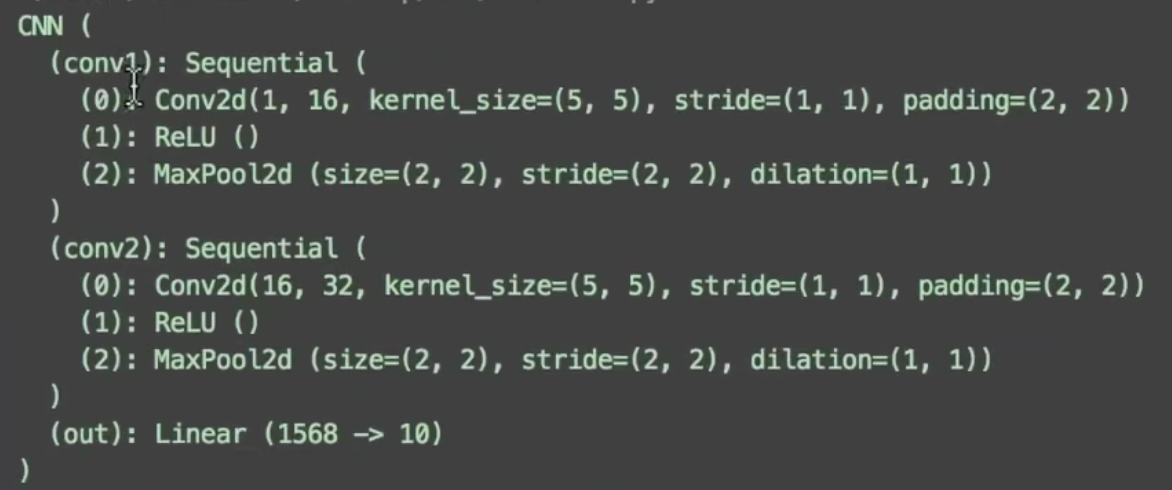卷积神经网络CNN(一)
对于CNN的学习,我先从代码部分入手,然后在学理论知识,两者相结合会达到豁然开朗的效果。
设置超参数
EPOCH = 1 # 训练整批数据多少次, 为了节约时间, 我们只训练一次 BATCH_SIZE = 50 LR = 0.001 # 学习率 DOWNLOAD_MNIST = True # 如果你已经下载好了mnist数据就写上 False
下载数据集(可以是Mnist手写数据,也可以是Fashion Mnist)作为训练数据与测试数据
if not(os.path.exists('./mnist/')) or not os.listdir('./mnist/'): # not mnist dir or mnist is empyt dir DOWNLOAD_MNIST = True train_data = torchvision.datasets.MNIST( root='./mnist/', train=True, # 指定这是训练数据
transform=torchvision.transforms.ToTensor(), # 将下载的数据转变为tensor形式的数据,并存储到train_data中 download=DOWNLOAD_MNIST, ) train_loader = Data.DataLoader(dataset=train_data, batch_size=BATCH_SIZE, shuffle=True) # 选择2000个样本进行测试 test_data = torchvision.datasets.MNIST(root='./mnist/', train=False) test_x = torch.unsqueeze(test_data.test_data, dim=1).type(torch.FloatTensor)[:2000]/255. test_y = test_data.test_labels[:2000]
建立CNN模型:使用class来建立CNN模型,整体流程是卷积(Conv2d)-->激励函数(ReLU)-->池化,向下采样(MaxPooling)-->再来一遍-->接入全连接层(Linear)-->输出
【模型中的具体参数的理解见另一篇博客:卷积神经网络CNN(二) - Tzy0425 - 博客园 (cnblogs.com)】
class CNN(nn.Module): def __init__(self): super(CNN, self).__init__() self.conv1 = nn.Sequential( # 输入一张长宽为28的灰度图片,形状为(1, 28, 28) nn.Conv2d( in_channels=1, # 输入图片的高度(本例中使用灰度图片,为1;若为RGB图片,则为3) out_channels=16, # 经过过滤层扫描输出16个特征 kernel_size=5, # 过滤层的大小(长宽为5) stride=1, # 过滤层移动的步长 padding=2, # 在输入的图片边缘填充2层像素 ), # 输出的形状为(16, 28, 28) nn.ReLU(), # 激活函数 nn.MaxPool2d(kernel_size=2), # 相当于另一个过滤层,在每个2*2的范围选择一个最大值作为输出, 输出形状就被压缩为(16, 14, 14) ) self.conv2 = nn.Sequential( # 上一层的输出是这一层的输入,(16, 14, 14) nn.Conv2d(16, 32, 5, 1, 2), # 这里的参数和上一层的参数含义完全一致,输出(32, 14, 14) nn.ReLU(), nn.MaxPool2d(2), # 输出(32, 7, 7) ) self.out = nn.Linear(32 * 7 * 7, 10) # 连接Linear层,输出有10个分类,目前是3维数据,我们要展平为2维数据,在forward中进行 def forward(self, x): x = self.conv1(x) x = self.conv2(x) x = x.view(x.size(0), -1) # 最终的输出数据形式为:(batch_size, 32 × 7 × 7) output = self.out(x) return output, x # 返回x到可视化 cnn = CNN() print(cnn) # 打印cnn的结构
CNN的结构:

训练数据
for epoch in range(EPOCH): for step, (b_x, b_y) in enumerate(train_loader): # enumerate表示输出时同时列出数据和数据下标 output = cnn(b_x)[0] loss = loss_func(output, b_y) # cross entropy loss损失函数 optimizer.zero_grad() # 清空梯度 loss.backward() # 反向传播,计算梯度 optimizer.step() # 更新参数
if step % 50 == 0: # 每50步看一下训练效果,看一下预测的准确率为百分之多少 test_output, last_layer = cnn(test_x) pred_y = torch.max(test_output, 1)[1].data.numpy() accuracy = float((pred_y == test_y.data.numpy()).astype(int).sum()) / float(test_y.size(0)) print('Epoch: ', epoch, '| train loss: %.4f' % loss.data.numpy(), '| test accuracy: %.2f' % accuracy)
运行结果:

最后取10个数据,看预测的值是否正确
test_output, _ = cnn(test_x[:10]) pred_y = torch.max(test_output, 1)[1].data.numpy() print(pred_y, 'prediction number') print(test_y[:10].numpy(), 'real number')
运行结果:




